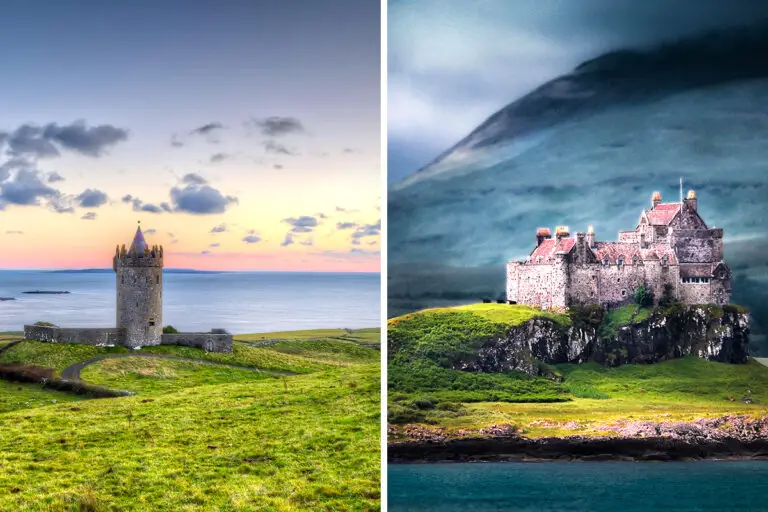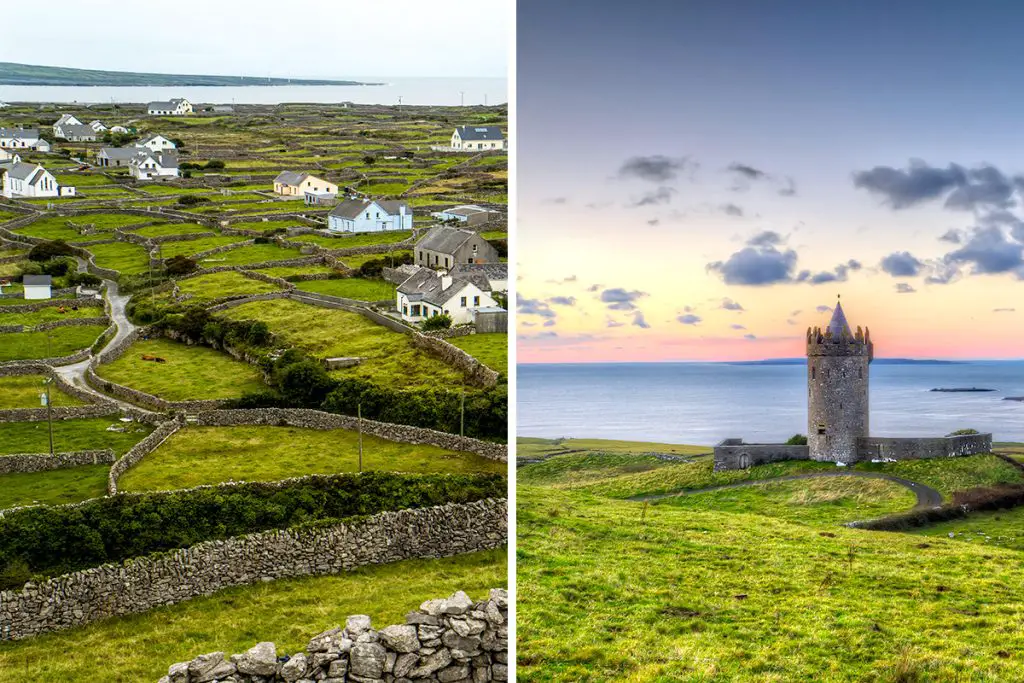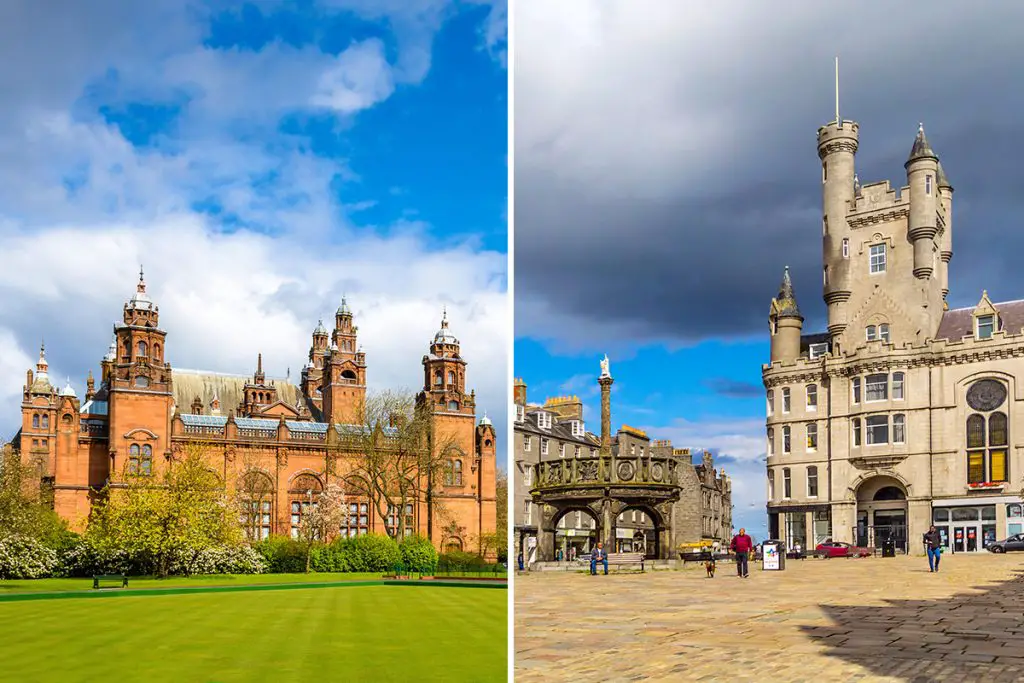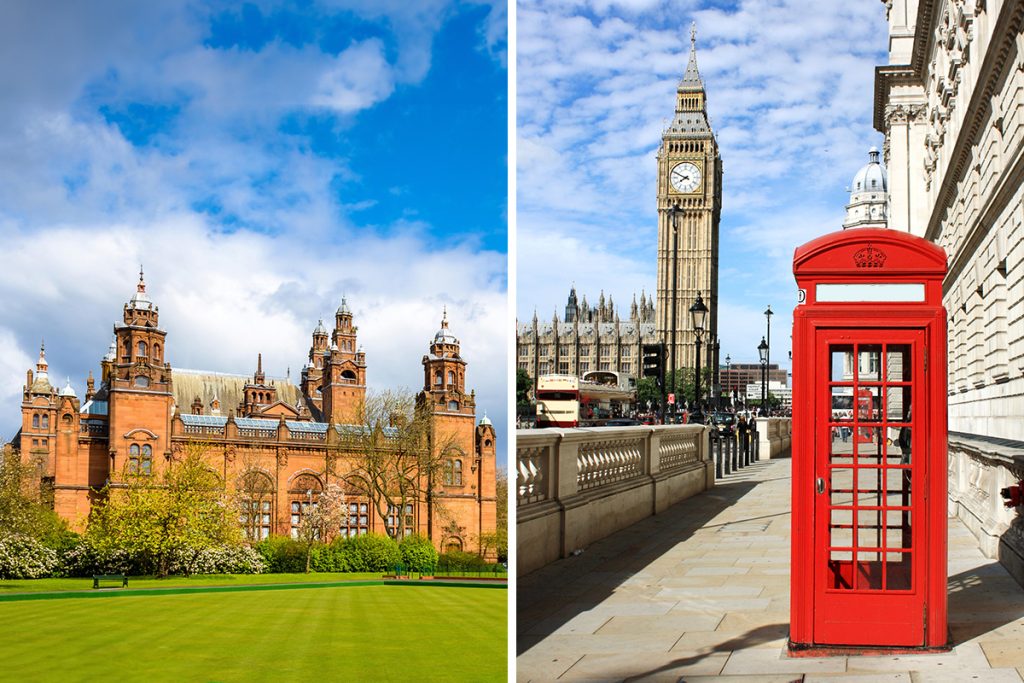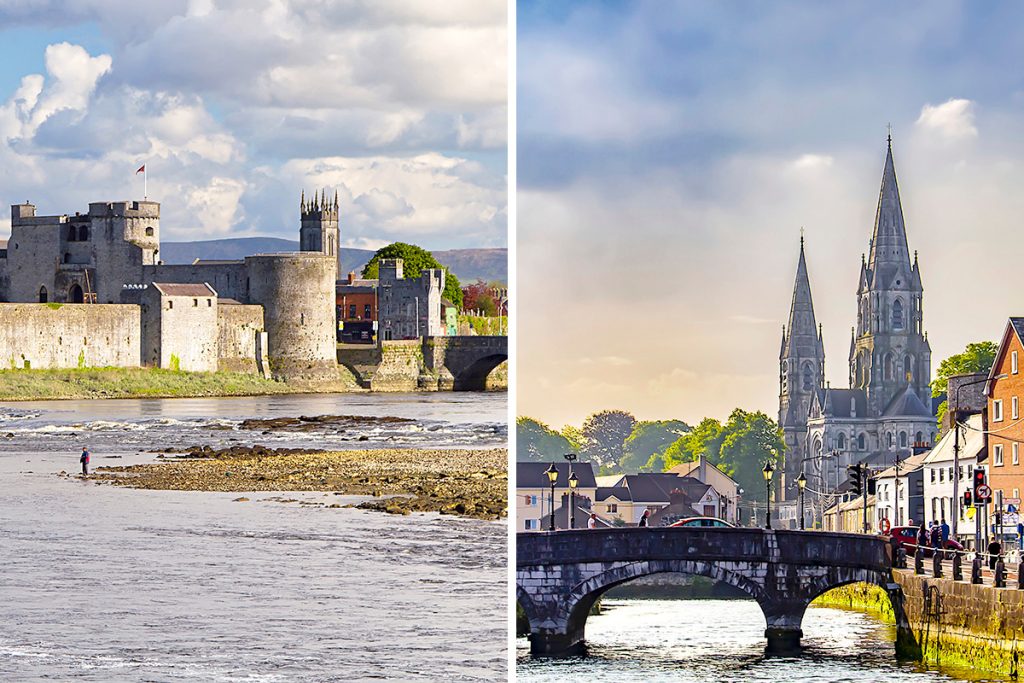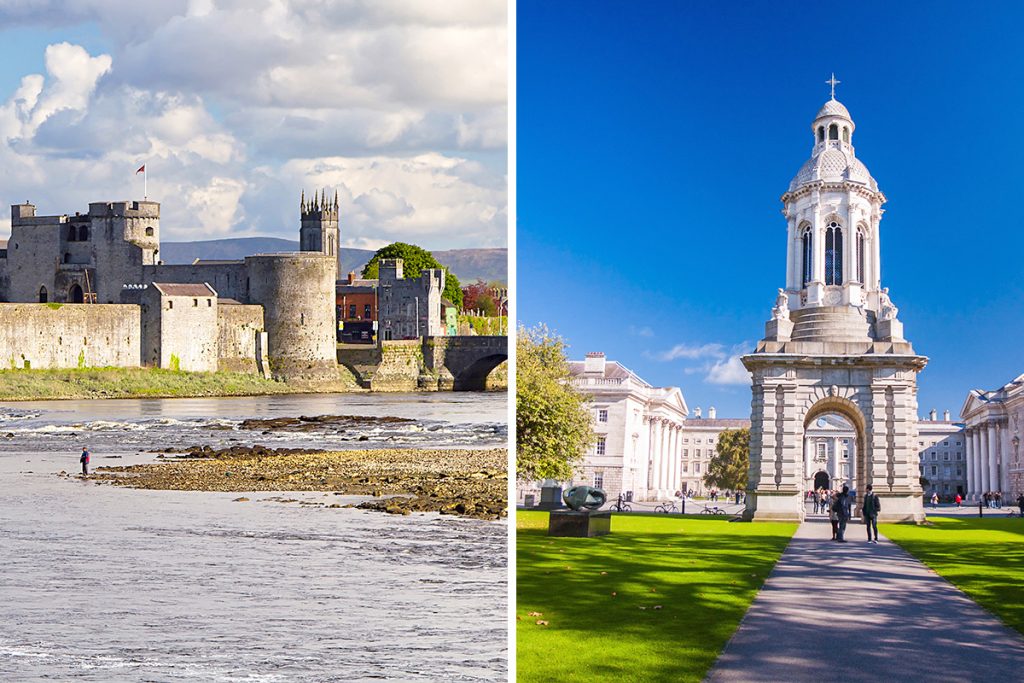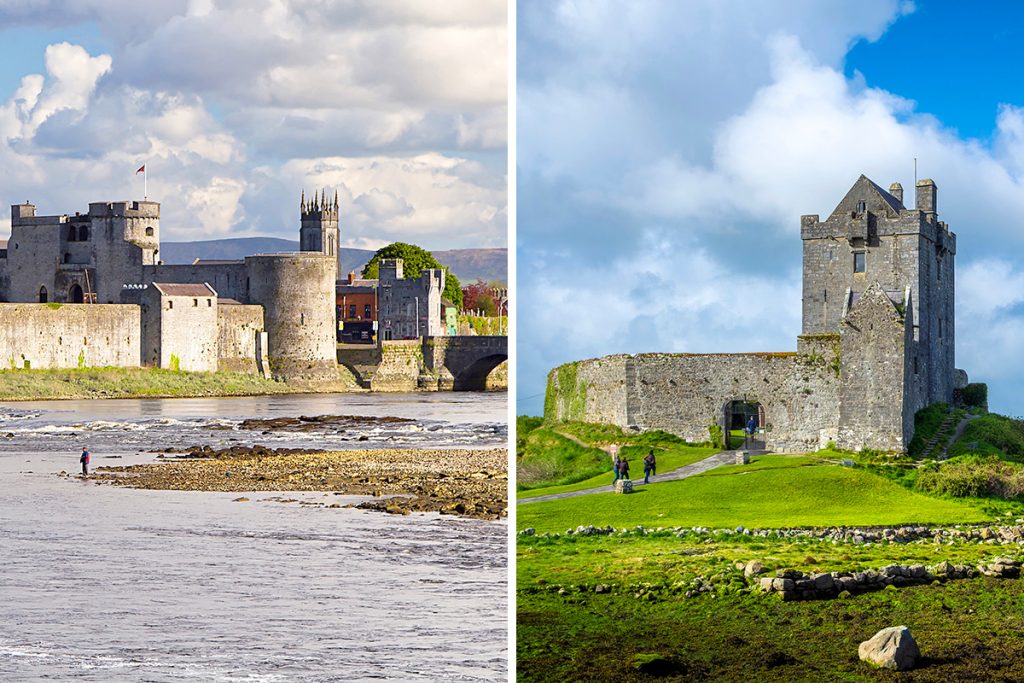Because of geographic proximity, Irish and Scottish people share the same ancestry. They’re descendants of Celtic tribes who resided in modern-day Ireland and Scotland. These two countries have similarities but some things make them unique from each other.
The cool climate and great landscapes in both countries are great for tourists. For folks who don’t like rain, Ireland might bum them out as rain is very frequent there. If you’re a person who doesn’t mind the rain, Ireland has a lot to offer. Irish castles, museums, and of course, the Guinness Storehouse are tourist attractions.
The mere mention of the name Scotland will remind you of kilts and bagpipes. You’re not wrong about that because those things are parts of Scottish identity and tradition.
There’s still a whole lot more to learn about Scotland and its culture. Like Ireland, Scotland also takes pride in the architectural designs of its castles. If the Irish have Guinness, the Scottish camp invites you to visit their distilleries.
Ireland
For a tourist who’s looking for real-deal medieval castles, Ireland is a place for you. But nature lovers are going to have a great time in this European country as well. The jaw-dropping sceneries can give visitors a laid-back and enjoyable experience.
Aside from the impressive view of nature and old castles, a trip to Ireland is not complete without Guinness. Ireland is home to cheerful people despite its gray skies and of course home to the world-famous Guinness Beer. The company’s brewery is open for visitors who want to get a taste of Ireland’s famous drink.
If you don’t drink alcohol, it’s not a big deal. Irish cuisine will not leave you starving because Ireland is also home to world-class chefs. Irish chefs, especially the ones in Dublin have perfected European cuisine. Your taste buds are in good hands.
Ireland is also a great place for tourists who love festivals. If you’re visiting on Saint Patrick’s Day, you’re going to witness Ireland’s joyful side. Don’t let the rain and clouds fool you so raise a pint in celebration of this country’s culture and people.
What Makes Ireland Unique
Majestic Castles
Ireland is home to 30,000 castles. It’s a dream destination for history and architecture buffs. The Republic of Ireland is not under monarchy rule anymore but these countless castles left their mark. These castles prove that even in the old times, human ingenuity was already present.
You have to keep in mind that Ireland and Northern Ireland are two separate entities/countries. Ireland’s government is following the parliamentary system. Northern Ireland’s government, on the other hand, is under a constitutional monarchy.
Some of the most famous castles in the country are Slane Castle, Kilkenny Castle, and Carrickfergus Castle. Those are only a few to an endless list. Wherever you are in Ireland, it’s not impossible to spot a castle near you.
The fact that these castles are still standing is proof of how well-built and well-preserved they are. They’ve been standing on Irish landscapes for ages. Come and marvel at the rich and royal beauty of Ireland’s past by taking some photos of its castles.
The Irish castles are not only limited to backgrounds. These amazing castles are great subjects on their own. Every stone and every crack on their walls can tell different stories about what life in Ireland was like back in the day.
Diverse Dishes
Food in Ireland is amazing because dishes are not limited to traditional Irish recipes. Sure, you can try the authentic versions of Irish Stew, Soda Bread, Champ, and Coddle. But chefs in Ireland, especially in Dublin, are not afraid to mix things up.
Dublin chefs don’t cook in the confines of traditional Irish dishes. They’re not hesitant to add elements from Asian and other European dishes to their cooking. Aside from the well-loved spuds, you can also get a taste of rice and noodle dishes in Ireland.
Take a trip to Ireland if you’re looking for a food-related adventure. The restaurants have enough variety that you don’t have to eat the same meal twice. It’s a place where you can travel the world through your taste buds.
A vacation in Ireland is surely a wonderful treat. After a tiring day of exploration, a meal at a nearby restaurant will satisfy your famished tummy. The impressive food selection in Ireland will keep your vacation meals fresh and interesting.
Guinness Storehouse
If you’re a tourist who’s fond of having some booze, Ireland can scratch your beer-drinking itch. Ireland is Guiness’ place of origin, and the storehouse of this dark-colored beer is open to curious tourists. Don’t be afraid to stop by if you’re somewhere in Dublin.
A single self-guided tour to its storehouse usually takes 90 minutes. That’s a great way to pass some time and learn about the company’s history and production. There are video presentations and exhibits that give visitors additional information.
Once you’re done with the tour, you’re going to get at least one free serving of this Irish drink. There are ticket options that allow you to have more than one serving, but please drink responsibly. You can also participate in tasting sessions if you’re looking for a more social and interactive experience.
For those who don’t drink alcohol, a trip to this side of Dublin is still worthwhile because the things that you’re going to learn will give you some insight into Irish drinking culture. Food and drinks do tell colorful and tasty stories about a country’s rich history and tradition.
St. Patrick’s Day
Irish communities in other parts of the globe indeed celebrate St. Patrick’s day. But to get a full experience of this awesome holiday, come to Ireland if you can. Saint Patrick is the patron saint of Ireland, and his feast day is religiously and culturally significant.
Despite the conflicting ideologies of Catholics and Protestants, both groups celebrate this holiday.
Four-leaf clovers and different depictions of a small creature called the leprechaun. The four-leaf clover symbolizes faith, hope, love, and luck. The leprechaun originated from Irish folklore that was heavily influenced by Celtic traditions.
The motifs and iconography of this holiday are an interesting mix of Christian and Celtic elements. Celebrating this day with the people gives you a glimpse of what shaped their lives.
The colors green, orange, and white are present in the flag of Ireland. So don’t be surprised if you see these colors more during the said holiday. The people in hotels, restaurants, pubs, and villages are in high spirits during this time.
Similar to Christmas, Saint Patty’s day is a time for celebration. Irish folks and tourists spend this day with music, food, and drinks. The Irish people’s jollier side is more evident during Saint Patrick’s day and you’re welcome to join in. You can dance and sing with the locals while enjoying some food and drink.
The festive energy is so contagious and you can’t help but join the fun. You can also get this vibe in some parts of the globe where Irish communities reside. But you’re going to experience this holiday’s purest form in the country where it started.
Scotland
Scotland. The land of Braveheart. This country is one of the four kingdoms in the UK and the second largest. It’s in the Northern part of England, Wales, and Northern Ireland. Scotland is a perfect country for tourists on holidays who like to gaze at stunning landscapes.
The icy mountains and peaceful countryside are recommended destinations for adventurers. You’re going to get a good mix of adventure and relaxation in this wonderful place. Compared to Ireland, Scotland doesn’t have much when it comes to the number of castles they have.
There are a lot of things going on in this wonderful kingdom and country. Scotland’s cities are full of life and energy because of its exciting musical events. Scottish are known for their traditional kilts and bagpipes.
Their music pieces are not dependent on that instrument alone. Harp, accordion, and fiddle are also instruments that add life to their musical numbers and parties. From traditional to modern, there’s always something for music-loving tourists out there.
While on a holiday, you can also visit Scotland’s top whisky distilleries. Scotch is a name used for whisky that came from this country. Alcoholic beverages are regularly consumed on this side of Europe. The climate must have something to do with that.
Nature and adventure lovers will have a great experience here in Scotland. The abundance of music-related festivities in its cities will leave your ears happy. But Scotland’s countryside is the spot for visitors who appreciate some tranquility.
What Makes Scotland Unique
Stunning Landmarks
An excursion is not a success without doing some sightseeing. Scotland’s just the right place for that. The beauty of this kingdom’s scenery is just breathtaking. The Scottish highlands are an attraction for tourists who love hiking.
Now that you’ve spotted the mountainous landscapes, there are some great coastal attractions as well. The Dunnottar castle is a medieval fortress located on a huge rock formation above the Northern Seas in Aberdeenshire. This is where mother nature and human creations meet.
Loch Ness is a lake in the Scottish highlands that is believed to be the home of the giant Loch Ness monster. The Loch Ness monster is one of the famous creatures of Scottish folklore.
The National Wallace Monument is also one of Scotland’s most famous landmarks. It’s a tower that’s been made in commemoration of Sir William Wallace’s life and heroism. He’s one of Scotland’s martyrs who bravely faced torture and execution. It was his last act of defiance against King Edward I of England.
There are plenty of special places to visit in Scotland. They can’t match Ireland’s number of castles but the lower number doesn’t affect this country’s beauty. Loch Ness lake, Wallace Monument, Scottish Highlands, and Dunnottar castle are all unique places.
Aside from the attractions mentioned, there are more to discover so don’t hesitate to explore. Though Scottish people are usually reserved, they are more than happy to entertain a curious visitor. Scotland’s people are proud of their identity and history so they don’t mind sharing some knowledge.
The majestic landmarks and their rich history are worth visiting. You can’t dismiss them because these places are heavily ingrained in Scotland’s wonderful country. Take your camera with you so that you can keep the beautiful visuals in a neat album.
Music Festivals
The music culture in Scotland is colorful. The abundance of musical events and festivals is evidence of how much the locals value music. From traditional folk music to jazz and more music genres, music is always a big thing here.
Some of the popular music festivals in Scotland are Orkney Folk Festival and Glasgow Summer Sessions.
Orkney Festival is focused on folk music and it’s a great event for tourists with old souls. This is where musicians will showcase musical styles and instruments that are close to Scotland’s heart. Glasgow Summer Sessions is a musical event that is more focused on contemporary music.
Rock and Hip Hop artists are usually present to perform at the said festival. For those who love dance music Terminal V is a go-to event. There are more music festivals all over Scotland throughout the year that’ll make you tap your feet.
There are distorted guitars, guttural screams, danceable beats, and mellow piano sounds. You name it. The diverse genre in every festival will give attendees a unique and memorable experience. In the venues, there’s plenty of food, drinks, and merchandise to choose from.
If you are going to one of these shows, make sure that you’re in good condition so you can keep up with the exhilarating experience that music festivals do offer. Don’t worry because some events are less chaotic than others, so mosh pits are not everywhere.
Whisky Distilleries
Visiting Scotland is an absolute dream for liquor connoisseurs out there. Scottish distilleries have mastered the art of making whisky or scotch. Scotland’s whisky bottles made for exportation are commonly known as Scotch abroad.
If you enjoy the buzz or rush that you get from whisky, Scotland is a good place to visit. Highland Park Whisky, Glenfiddich, Glenlivet, and Laphroaig distilleries are open for tours. Learn about the processes that whisky goes through before ending up in nice-looking bottles.
You can visit Edinburgh’s Scotch Whisky Experience for a large collection of bottled liquors. It’s not exactly a distillery, but it’s more of a liquor museum that’s worth checking out. You’ll find 12-, 15-, and 18-year bottles in Edinburgh’s whisky haven.
Learn more about the taste, smell, processes, and history of famous and well-loved whisky brands. Even people who don’t drink might learn some interesting facts about Scotland’s favorite liquor. Make a reservation or avail tickets to enter and roam inside these establishments.
To book a tour, try getting in touch with a distillery through their official websites. Barging in without prior notice can only lead to puzzled looks and feelings of disappointment. Keep track of the schedules to successfully score a tour date for a smooth and hassle-free visit.
After the tour, you can buy some bottles for drinking or take them home as souvenirs and gifts. Get your glass and pour some good ol’ whisky to chill but don’t overdo it. Whisky/scotch is also a good drink to enjoy the holidays with fellow tourists and Scottish friends.
Local Produce
Purchasing or consuming local produce is quite an experience in Scotland. The countryside is well-cultivated and colorful, so a trip outside the cities is equally exciting. As your body and eyes wander, you’ll be delighted that the land around you is not barren.
Scotland’s soil is good for agriculture and taking care of livestock. Spring barley is the main type of crop, but you can also find other good-quality crops here. Winter wheat, potatoes, and strawberries are also grown and sold to locals and tourists.
Sheep and cows are the most common livestock on their farms. The livestock in small-scale farms eat organic stuff, and that’s great news for health-conscious tourists. The products from local Scottish farms don’t go through the corporate practice of mass production.
Quality usually suffers because of mass production and heavy circulation. So buying local produce gives you quality while supporting small-scale farmers in return. Visiting their farms allows you to taste quality crops.
The slow-paced atmosphere of the countryside will make any visitor feel at ease. There are also a lot of human elements that can make you appreciate agriculture. Farmers who see how people appreciate their labor and harvest will feel flattered.
Yes. Some Scottish folks are reserved but they’re not standoffish or unfriendly. The hardworking folks will give you that warm reception especially if you’re showing support for what they do. Enjoy the harvest and have a chat with the locals if you want to get away from the city for a while.
Good food and conversations in a slow-paced background are great for making vacation memories. Let the child in you take a step back and absorb the simplicity and peace of Scottish farms. The simpler way of life reminds you that not all things need to be super commercialized.
Scotland or Ireland – Which Is Better?
Both Scotland and Ireland are worth visiting. A tourist’s expectations will decide if one country is slightly better than the other.
If you’re a nature lover who likes stunning landscapes and enjoys music festivals, Scotland is preferable. For a tourist who marvels at medieval castles and diverse food, Ireland is the place to visit.
People in Scotland are more reserved but they’re still approachable. Irish people on the other hand are usually more cheerful and don’t have problems welcoming tourists.
This is not a jab against Scotland because it’s a very amazing place. But extroverts and social butterflies might need more effort in connecting with the locals there. The countless music festivals make socializing a bit easier.
For variety, architecture, and social interactions, Ireland is the winner. Scotland wins if tourists like music, local produce, and natural landmarks. It’s a matter of preference, so picking is somehow a challenging task.
In Ireland, you can get along with people in an instant. Ireland is a place for adventurous tourists who like to socialize and explore different things.
Scotland is a perfect destination for music fans and tourists who prefer the peacefulness of the countryside. Since most tourists want to spend their vacation by taking things slow with nature, Scotland seems better.
Stuff in Scotland is also slightly cheaper than products in Ireland. Those factors can make your trip to Scotland vacation sound like a very good deal.
If you’ll excuse the boxing terms, Scotland didn’t beat Ireland with a knockout punch. But Scotland is a winner because of a split decision.
FAQ
Is Scotland or Ireland More Beautiful?
Scotland is hands down a naturally more beautiful destination. The landscapes are more beautiful and they don’t cease to amaze people who come to visit. Make sure that you’ve got your camera with you to capture wonderful shots.
Which Is Safer – Ireland or Scotland?
Ireland and Scotland are generally safe countries to visit. If you stick to recommended routes and destinations, your trip is going to be safe. Some locals may advise you to avoid certain neighborhoods so try to focus on the landmarks of each country to make your vacation a good one.
Which Is Cheaper to Visit – Scotland or Ireland?
Most goods and services in Scotland are cheaper compared to Ireland. Ireland’s products are 18% more expensive than what you’ll get from Scotland and the rest of the United Kingdom. A minor price difference still means a lot if you’re on a tighter budget, so Scotland is a better option.
Is Scotland Richer Than Ireland?
Scotland is rich in natural resources but Ireland is a richer country. Ireland’s 498.6 Billion USD GDP is more than two times higher than Scotland’s 205 billion USD GDP.
The reason behind Ireland’s wealth is the huge presence of pharmaceutical and tech companies in its territory. Ireland is also the world’s top aviation/aircraft lessor.
Scotland’s economy is dependent on agriculture and tourism. Even though Ireland is the wealthier country of the two, you can’t assume that Scotland is struggling because it’s still a rich country.
Ireland vs. Scotland Weather
Though it’s usually cloudy or rainy in most parts of Ireland, Scotland’s weather is unfortunately more extreme. Scotland’s summer and winter seasons are sometimes unforgiving. The weather in Ireland is milder and more bearable despite the gray skies and frequency of rain.
Is Scotland Colder Than Ireland?
Since Scotland’s weather is more extreme, the winter and fall seasons are colder in Scotland. Even the summer nights are sometimes chilly. Scotland’s winter temperature is as low as 40°F (5°C) while in Ireland it’s 46°F (8°C) on average.
Sometimes, winters in both countries are equally cold, though Scotland’s temperature is still a degree lower. If you’re visiting during the cold months, pack your clothes accordingly. As previously mentioned, summer nights in Scotland can still be cold.
Best Time to Visit Ireland and Scotland
The best months to visit Ireland and Scotland are March to May and September to November. Those months are within spring and autumn.
During summertime, both places are crowded. The very cold winter makes going out a little difficult.
Ireland or Scotland for Golf?
Golf is a sport and recreational game that originated on the eastern coast of Scotland. There are 587 golf courses there. But golf is also a big deal in Ireland because there are 450 golf courses within its territory.
Ireland and Scotland’s wide areas of land make them perfect venues for golfing. If you are a fan of this game, you can visit the two countries to play or watch tournaments. They’re equally good for golfing when the weather’s really good.
How Far Apart Are Scotland and Ireland?
Scotland and Ireland are only 12 miles (19 km) apart from each other. Though separated by the Irish sea and Northern Ireland, the proximity makes their cultures closely related. Northern Ireland is a separate country from Ireland as it’s a part of the United Kingdom.
Can You See Ireland From Scotland?
If you put borders and territories into consideration, you can’t see Ireland from Scotland. But from somewhere in Scotland’s coastal area, Northern Ireland is visible. Northern Ireland and the Irish sea are sandwiched between Ireland and Scotland.
How Deep Is The Sea Between Ireland and Scotland?
The Irish sea is 315 meters (1,033 feet) deep. It’s the home of different aquatic animals despite its cold waters. Sunfish, eels, mackerel, lobsters, and crabs are just a few of them.
Are Scotland and Ireland Connected?
Geographically speaking, Scotland and Ireland are not connected. The two are only a few miles apart but they’re separated by the Irish sea. In terms of culture, the two countries do have a lot in common due to their shared Celtic ancestry.
There were plans to build a bridge to connect Scotland to Ireland. But the expenses and other challenges involved have prevented the said project from pushing through. Building a bridge has been planned and considered since the early 1900s but nothing has ever been built.
Is Ireland or Scotland Bigger?
Ireland is a bigger country than Scotland. The former covers an area of 84,421 square kilometers (32,595 mi²). The latter’s area is a bit smaller at 77,933 square kilometers (30,090 mi²).
Scotland can only dwarf Ireland’s size if you add other UK countries into the equation. Because Scotland is one of the countries in the United Kingdom. Ireland is a bigger country but it has a smaller population.
4.78 million people are living in Ireland while Scotland is populated by 5.29 million people. Don’t let the stats bother you because both countries are nice tourist destinations.
How to Get From Ireland to Scotland?
The convenient and faster way to get from Ireland to Scotland is by plane. The other options are traveling by ferry and train. If you choose to travel by train, there’s only one available direct train line from Dublin to Edinburgh. Other train lines include a ferry ride in the middle of the trip.
A ferry ride is slower but some ferry trips don’t travel from Scotland to Ireland’s republic directly. The most usual route is traveling from Scotland to Northern Ireland and vice versa. A ferry ride between a train trip from Edinburgh to Dublin is the most common alternative to a flight.
How Far Is Scotland From Ireland by Plane?
The flight distance between Ireland and Scotland is 210 miles (338 km). If you board a plane from Edinburgh to Dublin, it’ll take you 50 minutes to an hour to get there. These two aren’t so far from each other so you can visit both places during your vacation.
Is It Cheaper to Fly to Scotland or Ireland?
Plane ticket prices may vary depending on your preferred flight class. Some airlines have cheaper options than others. But in general, Ireland’s plane tickets are a few dollars cheaper than Scotland’s plane tickets.
Airfare from Ireland can cost you 62 USD while a plane ticket in Scotland is around 69 to 70 USD. Ticket prices can fluctuate depending on the season, distance, and fuel prices. The majority of goods and services in Ireland are pricier but their plane tickets are usually cheaper.
Can You Take a Ferry From Ireland to Scotland?
There are ferry routes that can take you from Ireland to Scotland. If you’re coming from Dublin port, the ferry will take you to Wales. Upon arrival, you can start taking a train trip to Edinburgh, Scotland. The other option is boarding a ferry from Northern Ireland.
Though Northern Ireland is a separate territory, it’s still worth mentioning. One ferry route offers 5 trips while the other one operates 6 times. The two ferry routes operate 11 times combined in a single day. Ferry boats cross the Northern channel of the Irish sea to reach Scotland.
How Long Is the Ferry From Ireland to Scotland?
The ports between Ireland and Scotland are 264 miles (425 km) apart. Northern Ireland’s port of Lane is just 140 miles (225 km) from Port Glasgow. As mentioned, you have to make a stopover in Wales if you are boarding a ferry from Dublin. From Wales, you can ride a train to go to Scotland.
Ireland to Scotland by Train
You can travel from Ireland to Scotland by train but don’t forget that the Irish sea is in between. Train routes involve a ferry ride in the middle of two train trips so you can get from Ireland to Scotland.
How Far Is Scotland From Ireland by Train?
Scotland’s Edinburgh and Ireland’s Dublin train stations are 218 miles (351 km) apart. There are 5 direct train trips in a day. The average price for a train ticket is 64 USD and the travel time is 14 hours and 30 minutes long.
Driving In Scotland vs. Ireland
Most roads in Scotland and Ireland are narrow. The intersecting and winding roads in both countries can make driving a challenge. But it’s easier to drive on Scottish roads.
For a smoother drive in Scotland, using a smaller vehicle is advised. Because the roads are narrow, tourists who drive large vehicles can have a hard time. Make sure that you’re calm and focused while driving to avoid accidents.
Day Trip to Scotland From Ireland
To fully experience the best of both countries, you’re going to need 14 days. But a day trip from Ireland to Scotland is possible if your vacation is shorter. You can do this by choosing faster transportation and visiting fewer tourist destinations.
The short distance between the two countries makes a day trip possible. Train and ferry rides are not ideal for day trips because they’re time-consuming. The best option to visit both countries in a day is to travel by plane.
Best Way to Get From Ireland to Scotland
The best and fastest way to get from Ireland to Scotland is by plane. Plane trips last for 1 to 4 hours depending on where you’re boarding a plane and your destination. By train, the travel time can take 5 to 10 hours.
If you are traveling from Northern Ireland to Scotland, ferry trips only take 2 hours. But if you’re traveling from the Republic, especially from Dublin, your trip will take more time. A plane is your best option especially when you’re on a tighter schedule like a day trip.

